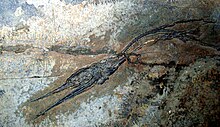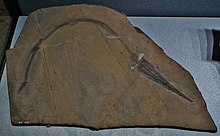Saurichthys
| Saurichthys | |
|---|---|

| |
| Saurichthys fossil | |
| Scientific classification | |
| Domain: | Eukaryota |
| Kingdom: | Animalia |
| Phylum: | Chordata |
| Class: | Actinopterygii |
| Order: | †Saurichthyiformes |
| Family: | † Saurichthyidae
|
| Genus: | †Saurichthys Agassiz, 1834 |
| Type species | |
| †Saurichthys apicalis Agassiz, 1834
| |
| Species | |
| |
| Synonyms | |


Saurichthys (from
Fossils of Saurichthys have been found on all continents except South America and
Over 50 species of Saurichthys have been described (see list below). The species differ in size and show variability in their skeletal features. The latter can potentially be ascribed to changes in major developmental genes.
Louis Agassiz, who described the type species of Saurichthys in 1834, named it the "lizard fish" because of skeletal features that he thought were intermediate to reptiles and fishes.
Their exact phylogenetic position is uncertain, though it is agreed that they are not members of Neopterygii. Historically, they have been seen as close relatives of the Acipenseriformes (which includes living sturgeon and paddlefish) as part of the Chondrostei, though this has been strongly questioned by modern studies, which suggests that it may lie outside the Actinopterygii crown group.[5]
Appearance

Saurichthys was an elongate, streamlined fish, commonly about 0.6 metres (2.0 ft) to 1 metre (3.3 ft) long. Some species were only a few
Species of Saurichthys had an elongate bodyform superficially similar to the modern
The
Ecology and Evolution

Large species of Saurichthys were apex predators among Triassic ray-finned fish, together with the marine Birgeria (Birgeriidae).
Saurichthys is classically interpreted as an ambush predator, similar modern gars and needlefish. It is suggested that it first approached its prey and then suddenly accelerated towards it.[15] Some species may have lived as subsurface cruisers (Sinosaurichthys).[17]
Specimens showing half-swallowed conspecific individuals suggest that
A study on the gastrointestinal tract of Saurichthys found similarities with present-day sharks and rays, in particular the many windings in the spiral valve. The many windings increased the surface area for digestion, which is sure to have provided the fish with more energy. It indicates that Saurichthys had an energy-laden lifestyle.[19]
Early Triassic species of Saurichthys[18] differ from later species most prominently in their more elongate postorbital portion of the skull (part of the skull behind the eyes) and their generally denser scale cover. Middle Triassic and Late Triassic species, on the other hand, typically have a short postorbital portion of the skull and their scale cover is reduced. This reduction includes both the number of the longitudinal scale rows and the size of individual scales.[8] These evolutionary trends are, however, not an indication for anagenesis, but rather the result of parallel evolution in different lineages of Saurichthys. The aforementioned trends are observed only in marine species. Late Triassic freshwater species of Saurichthys (e.g., S. orientalis, S. sui) retain an elongate postorbital skull portion and a denser scale cover, suggesting that freshwater environments served as refugia for species with a more primitive appearance.[8][20]
Reproduction

Fossils of gravid females provide evidence for (ovo-)viviparity in Saurichthys[21] and the oldest known example for viviparity in ray-finned fishes.
Internal fertilisation is also evidenced by specialized pelvic fin rays (
Species
This list includes species of Saurichthys that are generally considered valid (based on Romano et al.[8] and references cited below). The validity of species that are based on fragmentary material (e.g., isolated scales or teeth) is questionable (see below).





- †Saurichthys (Costasaurichthys Tintori 2013)
- †Saurichthys (Costasaurichthys) costasquamosus Rieppel 1985
- †Saurichthys (Costasaurichthys) paucitrichus Rieppel 1992
- †Saurichthys (Eosaurichthys Liu and Wei 1988)
- †Saurichthys (Eosaurichthys) chaoi (Liu and Wei 1988)
- †Saurichthys (Eosaurichthys) madagascariensis Piveteau 1945[18]
- †Saurichthys (Lepidosaurichthys Tintori 2013)
- †Saurichthys (Lepidosaurichthys) dayi (Raymond 1925)
- †Saurichthys (Lepidosaurichthys) elongatus Stensiö 1925
- †Saurichthys (Lepidosaurichthys) ornatus Stensiö 1925
- †Saurichthys (Lepidosaurichthys) toxolepis Mutter et al. 2008
- †Saurichthys (Lepidosaurichthys) wimani (Woodward 1912)[23]
- †Saurichthys (Saurorhynchus Agassiz 1844)
- †Saurichthys (Saurorhynchus) calcaratus Griffith 1977[24]
- †Saurichthys (Saurorhynchus) deperditus (Costa 1862)
- †Saurichthys (Saurorhynchus) striolatus Bronn 1858[24]
- †Saurorhynchus acutus (Agassiz 1844)
- †Saurorhynchus anningae Maxwell & Stumpf 2017
- †Saurorhynchus brevirostris (Woodward 1895)
- †Saurorhynchus hauffi Maxwell & Stumpf 2017
- †Saurichthys (Sinosaurichthys Wu et al. 2011)
- †Saurichthys (Sinosaurichthys) longipectoralis Wu et al. 2011
- †Saurichthys (Sinosaurichthys) longimedialis Wu et al. 2011
- †Saurichthys (Sinosaurichthys) minuta Wu et al. 2011
- †Saurichthys apicalis Agassiz 1834 (type species)
- †Saurichthys breviabdominalis Maxwell et al. 2015[25]
- †Saurichthys curionii (Bellotti 1857)
- †Saurichthys daubreei Firtion 1934
- †Saurichthys dawaziensis Wu et al. 2009
- †Saurichthys dianneae Maxwell et al. 2016
- †Saurichthys dongusensis Minich 1992
- †Saurichthys eximius Minikh 1982
- †Saurichthys gigas (Woodward 1890), non-von Quenstedt 1858
- †Saurichthys gracilis (Woodward 1890)
- †Saurichthys grignae Tintori 2013
- †Saurichthys gypsophilus Reis 1892
- †Saurichthys hamiltoni Stensiö 1925
- †Saurichthys hoffmanni Werneburg et al. 2014
- †Saurichthys huanshenensis Chou & Liu 1957
- †Saurichthys irregularis Oertle 1928
- †Saurichthys latifrons Eck 1865
- †Saurichthys lepidosteoides Frech 1903
- †Saurichthys macrocephalus (Deecke 1889)
- †Saurichthys majiashanensis Tintori et al. 2014
- †Saurichthys minimahleri Werneburg et al. 2014
- †Saurichthys nepalensis Beltan & Janvier 1978
- †Saurichthys obrutchevi Minich 1981
- †Saurichthys orientalis Sytchevskaya 1999
- †Saurichthys parvidens Wade 1935
- †Saurichthys piveteaui Beltan 1968
- †Saurichthys proximus Minich 1981
- †Saurichthys rieppeli Maxwell et al. 2015[25]
- †Saurichthys sceltrichensis Renesto et al. 2021[12]
- †Saurichthys seefeldensisKner 1867
- †Saurichthys spinosa Wu et al. 2018[26]
- †Saurichthys stensioi Lehman 1952
- †Saurichthys sui Fang & Wu 2022[20]
- †Saurichthys taotie Fang et al. 2023
- †Saurichthys tenuirostris Münster 1839[27]
- †Saurichthys tertius Minich 1982
- †Saurichthys ultimus Minikh 1992
- †Saurichthys vjuschkovi Minikh 1983
- †Saurichthys yangjuanensis Wu et al. 2015
- †Saurichthys yunnanensis Zhang, Zhou, Lu & Bai 2010
Species based on fragmentary fossils
- †Saurichthys aculeatus Henry 1876
- †Saurichthys annulatus Winkler 1880
- †Saurichthys catalaunicus (Betlan 1972)
- †Saurichthys indicus de Koninck 1863
- †Saurichthys listroconus Plieninger 1844
- †Saurichthys longiconus Agassiz 1834
- †Saurichthys longidens Agassiz 1844
- †Saurichthys osseus (Betlan 1972)
- †Saurichthys semicostatus Münster 1839
- †Saurichthys striatulus Henry 1876
- †Saurichthys subulatus Henry 1876
Synonyms
- †Saurichthys acuminatus Agassiz 1844 → †Birgeria acuminata
- †Saurichthys acutus Agassiz 1844 → †Saurorhynchus acutus
- †Saurichthys brevirostris (Woodward 1895) → †Saurorhynchus brevirostris
- †Saurichthys costatus Münster 1839 → †Birgeria? costata
- †Saurichthys elegans Stensiö 1925 → †Saurichthys elongatus
- †Saurichthys intermedius (Bassani 1886) → †Saurichthys curionii
- †Saurichthys krambergeri Schlosser 1918 → †Saurichthys deperditus
- †Saurichthys mougeoti Agassiz 1844 → †Birgeria mougeoti
- †Saurichthys robustus Bassani 1886 → †Saurichthys curionii, †Saurichthys macrocephalus, †Saurichthys costasquamosus
- †Saurichthys stoppanii (Bassani 1886) → †Saurichthys curionii
See also
- Prehistoric fish
- List of prehistoric bony fish
References
- ^ a b c Stensiö, E. (1925). "Triassic Fishes from Spitzbergen, Part II". Kungliga Svenska Vetenskapsakademiens Handlingar. 3: 1–126.
- ^ a b Cartanyà, J. (1999). "An overview of the Middle Triassic actinopterygians from Alcover, Mont-ral and El Pinetell (Catalonia, Spain)". In G. Arratia; H. P. Schultze (eds.). Mesozoic Fishes 2—Systematics and Fossil Record. München: Friedrich Pfeil. pp. 535–551.
- PMID 24647136.
- .
- ^ PMID 30382811.
- ^ Saurichthys at Fossilworks.org
- ^ Mutter, R. J.; Cartanyà, J.; Basaraba, S. A. U. (2008). "New evidence of Saurichthys from the Lower Triassic with an evaluation of early saurichthyid diversity". In G. Arratia; H.-P. Schultze; M. V. H. Wilson (eds.). Mesozoic Fishes 4—Homology and phylogeny. München: Friedrich Pfeil. pp. 103–127.
- ^ .
- .
- .
- PMID 20853419.
- ^ .
- ^ Beltan, Laurence; Janvier, Philippe; Monod, Olivier; Westphal, Frank (1979). "A new marine fish and placodont reptile fauna of Ladinian age from southwestern Turkey". Neues Jahrbuch für Geologie und Paläontologie, Monatshefte. 1979 (5): 257–267.
- S2CID 84992418.
- ^ PMID 26603471.
- S2CID 233840332.
- .
- ^ S2CID 87234436.
- PMID 26732746.
- ^ S2CID 250567176.
- S2CID 135337591.
- .
- ISBN 9783860125526.
- ^ S2CID 244984857.
- ^ a b Discovery of two new species of primitive fishes
- .
- ^ Fossilworks: Saurichthys Agassiz 1843
External links
- Saurichthys species information on paleodb.org.
